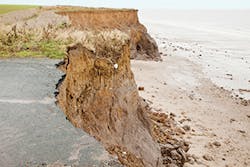Editor’s Comments: High and Low to Protect the Coast
With predictions of sea level rise anywhere from a few inches to several feet in the coming decades, coastal regions are scrambling to find ways to protect themselves, both from the slow erosion caused by encroaching waters and from the sudden devastation of hurricanes and storm surges.
Some cities have proposed—or have already built—high-tech mechanisms to do the job. They are mind-bogglingly expensive, but not building them might be more costly yet. For example, New York City’s proposed network of flood walls, levees, and bulkheads along more than 500 miles of coast will cost upward of $20 billion. In comparison, though, Hurricane Sandy caused about $19 billion in damage, not including economic losses from the temporary shutdown of businesses and transportation. New Orleans’ Hurricane Storm Damage Risk Reduction System, consisting of barriers, floodgates, and pump stations, cost $15 billion. Planned after Hurricane Katrina in 2005 and largely in place by the time Hurricane Isaac struck the city in 2011, the system is estimated to have averted $30 billion in damages that Isaac could potentially have caused.
The lessons learned from major storms like Katrina and Sandy are being put to good use. Although there is no turnkey solution—cities vary tremendously in their topography, their infrastructure needs, and their coastal land use—the design concepts and engineering solutions in places like New Orleans and New York will trickle down, so to speak, to other regions.
Even so, not everyone can afford such an elaborate system. What about low-tech solutions, natural barriers to protect the shoreline?
The Gulf Coast is relying on these too, with agencies like the Louisiana Coastal Protection and Restoration Authority working to save barrier islands and coastal marshes.
Researchers are also recognizing, or perhaps rediscovering, another valuable resource: mangroves, which grow throughout the tropics and thrive in saline and brackish waters. In many areas—especially those with sandy beaches frequented by tourists—mangroves have often been considered an undesirable nuisance. But scientists at the Universities of Auckland and Waikato in New Zealand and the University of Southampton in the UK recently published research showing how mangrove forests respond to elevated sea levels. Essentially, the trees trap sediment in their mesh-like roots, actually creating new ground and preventing seawater from encroaching landward. The forests and the infilled areas they create form a buffer.
This is not to suggest, of course, that we should begin planting mangrove forests around the perimeter of Manhattan. But research on natural solutions—vegetation, wetlands and marshes, even oyster reefs—will ultimately protect a greater amount of coastal land than high-tech barriers. For areas in which critical infrastructure and pricey real estate is not built right up to the water’s edge, these solutions have even more potential.
If you’re in a coastal region, what protection measures are underway in your area? What other efforts—from physical changes to rezoning—would you like to see? Let us know at [email protected].
About the Author
Janice Kaspersen
Janice Kaspersen is the former editor of Erosion Control and Stormwater magazines.


